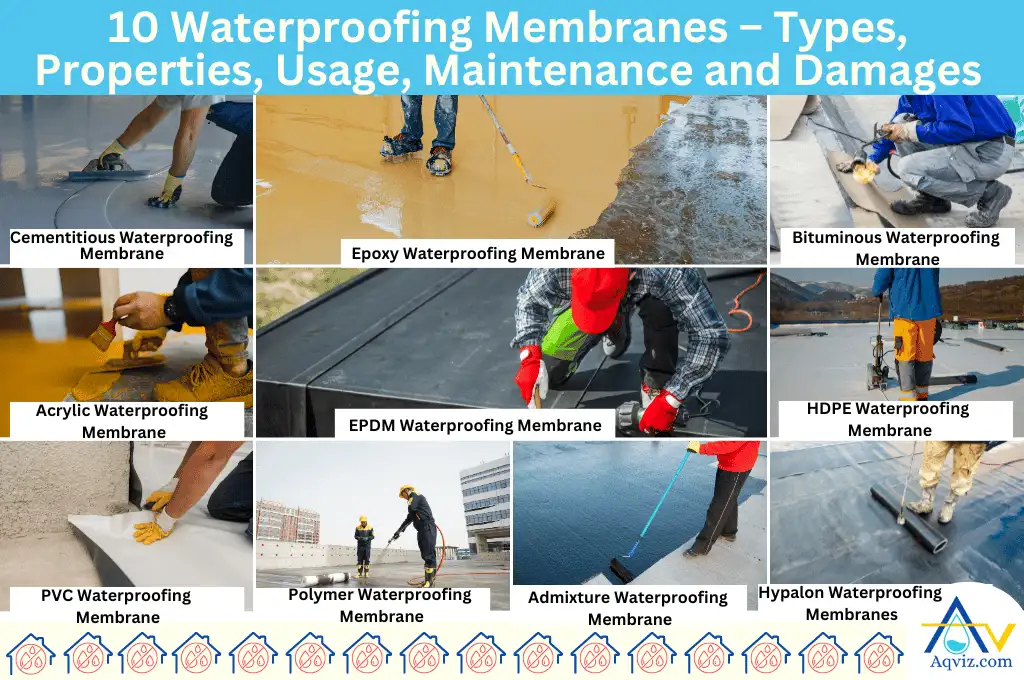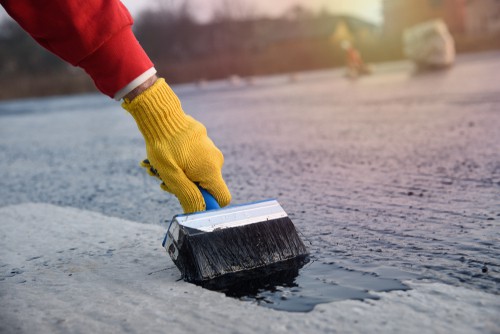Yard drainage Omaha: Real Results from Omaha Homes

Everything about Waterproofing: Recognizing Its Relevance and Benefits for Your Home
Waterproofing is an essential aspect of home upkeep that numerous property owners neglect. It offers to safeguard frameworks from the damaging results of water seepage, which can lead to substantial concerns with time. Understanding the various methods and their relevance can assist property owners make informed choices. As the conversation unravels, the genuine question continues to be: how can efficient waterproofing change a home's strength against moisture-related risks?
What Is Waterproofing and Exactly How Does It Work?
Waterproofing is an important process designed to safeguard buildings and structures from water seepage. It includes the application of various products and methods that develop a barrier, protecting against water from penetrating surfaces. Usual waterproofing techniques include making use of membrane layers, finishings, and sealants, which can be put on roofing systems, foundations, and wall surfaces. Each method is selected based upon the certain requirements and problems of the structure.The performance of waterproofing relies upon proper setup, guaranteeing that all locations are effectively covered and secured. Materials such as bituminous membrane layers, liquid waterproofing substances, and cementitious coverings are often utilized, each offering special benefits. Additionally, water drainage systems might be integrated to redirect water far from susceptible locations, further improving defense. Generally, waterproofing not just safeguards architectural stability yet likewise enhances long life, making it a crucial consideration in construction and renovation projects.
The Relevance of Waterproofing for Homeowners
Homeowners encounter various challenges in maintaining their properties, and one of one of the most substantial problems is water damages. This issue can emerge from numerous sources, consisting of heavy rains, flooding, and pipes failings. When left unaddressed, water damages can result in extreme architectural issues, mold development, and pricey repair work. Waterproofing stands as a necessary preventative action that shields homes from these possible risks.
Usual Waterproofing Methods and Strategies
When considering waterproofing approaches, house owners can select from a range of reliable remedies. Exterior waterproofing solutions concentrate on preventing water from permeating the framework, while indoor waterproofing methods address wetness problems once they have actually taken place. Understanding these choices is vital for preserving a completely dry and healthy home setting.
Outside Waterproofing Solutions
To safeguard a building from water intrusion, numerous exterior waterproofing solutions can be utilized, each customized to the certain needs of the structure. One common approach is the application of waterproof membranes, which develop a barrier versus moisture. These membranes can be either liquid-applied or sheet-based, depending on the setup needs. An additional efficient strategy includes making use of drainage systems, such as French drains, that redirect water away from the foundation. In addition, applying outside sealers can help secure surfaces from water penetration and corrosion. Landscaping solutions, consisting of grading and proper water drainage, can likewise contribute especially to preventing water buildup around the structure. Each of these techniques plays an important duty in improving the durability and longevity of the home.
Interior Waterproofing Techniques
Interior waterproofing techniques are important for guarding a home against dampness and water damage. Common methods include the application of sealers and membranes, which create an obstacle on walls and floorings to avoid water infiltration. Interior water drainage systems, such as sump pumps and French drains pipes, effectively redirect water far from vulnerable areas. In addition, vapor barriers can be mounted to block wetness from permeating via walls and floorings, particularly in basements and creep spaces (Basement waterproofing Omaha). Normal maintenance and inspection of these systems are essential to assure their effectiveness. Moreover, attending to any kind of plumbing leaks or condensation issues without delay can greatly enhance the general waterproofing strategy. With each other, these techniques provide homeowners with a detailed approach to reducing the risk of water-related problems

Signs Your Home Requirements Waterproofing
Property owners must know vital signs that their home may call for waterproofing. Visible water damage, mildewy odors, and regular mold and mildew growth are important indicators that dampness is jeopardizing the honesty of the home. Addressing these problems quickly can avoid further damage and guarantee a much healthier living setting.
Visible Water Damage
Visible water damage acts as a clear indicator that a home may require waterproofing measures. Property owners need to be watchful for signs such as water stains on wall surfaces or ceilings, peeling off paint, and deformed floor covering. These noticeable signs usually represent underlying wetness issues that, if left unaddressed, can lead to a lot more considerable damages and expensive fixings. Mold and mildew development can also take place, though it will be gone over in the following area. Furthermore, property owners ought to examine cellars and crawl rooms for wetness or efflorescence on concrete surfaces, which shows moisture infiltration. Seeing these indications early can aid protect against even more damage of the home's structural honesty. Timely waterproofing measures can guard the investment and keep a healthy living atmosphere.
Musty Odors Present
Musty odors are frequently an indication that wetness is sticking around in hidden locations of a home, indicating the requirement for waterproofing options. These undesirable smells often arise from moist cellars, crawl areas, or behind wall surfaces, where water seepage may not be immediately noticeable - Yard drainage Omaha. Property owners must pay close attention to these odors, as they suggest that excess humidity is caught, possibly resulting site in additional damage. The visibility of stuffy scents can endanger interior air top quality, influencing the wellness and convenience of homeowners. Ignoring this alerting indication can result in extra severe problems, making timely evaluation and action necessary. By attending to waterproofing requirements, homeowners can eliminate stuffy odors and develop a much healthier living atmosphere
Regular Mold And Mildew Growth
Frequent mold and mildew growth is a clear indicator that a home might be experiencing moisture issues, requiring waterproofing measures. Mold and mildew flourishes in damp atmospheres, making it a substantial problem for house owners. Indications of mold can consist of dark areas on wall surfaces, ceilings, and around home windows, as well as a relentless mildewy odor. If mold and mildew appears repeatedly regardless of cleaning Click This Link up initiatives, it suggests underlying dampness issues. This can result from leakages, insufficient drainage, or high moisture levels. Ignoring these signs can cause structural damages and health risks, specifically for individuals with respiratory system problems. Subsequently, attending to waterproofing promptly can aid mitigate mold and mildew development, making sure a more secure and healthier living setting. Home owners must consider expert analyses to determine the level of the wetness trouble.
The Long-Term Conveniences of Buying Waterproofing
Spending in waterproofing uses house owners an extensive feeling of safety and tranquility of mind, recognizing their home is secured versus moisture-related damage. This proactive approach significantly reduces the danger of structural problems, such as wood rot and foundation fractures, which can bring about pricey repairs over time. Additionally, waterproofing helps keep indoor air high quality by minimizing mold and mildew development, which can have adverse health and wellness effects for occupants.Furthermore, waterproofing enhances the longevity of a home, inevitably maintaining its worth. A well-protected home is much more attractive to potential purchasers, as they are waterproofing cost less most likely to run into concealed wetness issues. This investment also adds to power performance; properly secured spaces prevent drafts and decrease cooling and heating expenses. Overall, the long-lasting benefits of waterproofing not just guarantee the architectural stability of a home but additionally promote a much healthier living atmosphere and strengthen the property's bankability.
Selecting the Right Waterproofing Professional for Your Home
Just how can a house owner guarantee they select one of the most qualified waterproofing specialist for their requirements? The procedure starts with extensive research and acquiring numerous quotes. Home owners must look for experts with a strong credibility, verified credentials, and extensive experience in waterproofing. Inspecting on-line testimonials and requesting recommendations can provide important understanding into a professional's dependability and top quality of work.Moreover, it is necessary to inquire regarding the details waterproofing methods each specialist uses, as well as the materials utilized. Home owners must verify that the picked service provider is accredited and insured, which secures versus possible responsibilities. A credible specialist will certainly additionally offer a comprehensive agreement describing the scope of work, timeline, and warranty info. By focusing on these standards, homeowners can make informed choices, ultimately causing improved protection against water damages and an efficient waterproofing service tailored to their home's demands.
Regularly Asked Inquiries
Can Waterproofing Be Performed In Winter Season or Winter?
Waterproofing can be challenging during winter season or cold weather condition due to reduced temperatures influencing products' bond and curing procedures. However, specialized products made for cool conditions can make it possible for successful waterproofing applications also in cold weather.
Exactly how Often Should I Water-proof My Home?
The frequency of waterproofing a home commonly depends on various elements, consisting of environment and material quality. Experts suggest reviewing problems yearly and reapplying every five to 10 years, or quicker if substantial wear appears.
Does Waterproofing Affect Home Resale Value?
Waterproofing can significantly influence a home's resale worth (Foundation waterproofing Omaha). Possible purchasers often view waterproofing as a secure versus water damages and mold, raising the property's appeal and marketability, possibly causing higher deals and quicker sales
Is Do It Yourself Waterproofing Effective for All Homes?
The efficiency of DIY waterproofing varies by home. Factors such as residential property age, environmental problems, and existing damages impact results. Homeowners need to analyze their details conditions before trying do it yourself services to guarantee lasting security.

Are There Eco-Friendly Waterproofing Options Available?
Environment-friendly waterproofing options do exist, consisting of natural sealers like beeswax and plant-based items. These options lessen ecological influence while effectively shielding frameworks from water damage, appealing to house owners seeking lasting options for their waterproofing needs.